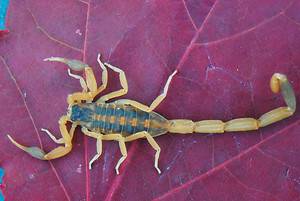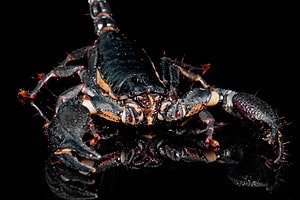Alabama is located in the Southeastern United States. It hosts two small scorpion species that are rarely harmful to people. Besides these two, the state is home to over 40 species of pseudoscorpions. But are these scorpions or not? Let’s find out!
What are scorpions?

There are over 2,650 described scorpion species spread around the world.
©Ernie Cooper/Shutterstock.com
Scorpions are predatory arachnids belonging to the Arachnida class and the Scorpiones order that are believed to have inhabited our planet for more than 400 million years!. There are over 2,650 described scorpion species spread around the world.
Appearance

Scorpions can be easily recognized because they have eight legs, a pair of pincers, and a narrow, segmented tail.
©Vova Shevchuk/Shutterstock.com
Scorpions can be easily recognized because they have eight legs, a pair of pincers, and a narrow, segmented tail. Their size can vary from 0.9 to 9 inches, although most individuals measure 2 inches. The largest scorpion is the giant forest scorpion, which holds the world record, with a length of nine inches and a weight of two ounces. The smallest scorpion is a Texas species, measuring 0.9 inches.
A scorpion’s color depends on the habitat it lives in. For example, forest scorpions are black, while desert scorpions have lighter shades. However, most scorpions are usually yellow or black. Some of them can be red, brown, or orange. The unique thing about them is that they change their color under ultraviolet light! “How’s this possible?” you must be wondering, right?! Well, this incredible feature is attributed to their exoskeletons that contain fluorescent chemicals that glow under UV light, making their hosts blue or blue-green!
Diet
Scorpions are very resistant when it comes to feeding because they can survive long periods without food.
When they hunt, they choose to feed on termites, wasps, beetles, grasshoppers, and small reptiles and mammals. These arachnids have several hunting methods. Some chase and ambush the prey. Others wait in burrows. Those with stronger venom sting the prey.
Scorpions are killed and eaten by lizards, snakes, frogs, birds, bats, and rodents.
Habitat
These arachnids live in subtropical or arid to semi-arid areas on all continents except for Antarctica. They are active during the night because they prefer lower temperatures. Otherwise, they hide under rocks, leaves, or logs. Unfortunately for people afraid of arachnids, scorpions can easily get into one’s house through gaps around doors or windows because they’re excellent climbers. When they get into the house, they’ll find a place to hide, often in shoes or between hanging clothes.
Lifecycle
Female scorpions can give birth to 100 baby scorpions at a time. Some scorpion species have a lifespan of 25 years.
Scorpions in Alabama
Alabama is home to two species of scorpions: the Hentz striped scorpion and the southern unstriped scorpion. Let’s find out more about them!
Hentz Striped Scorpion
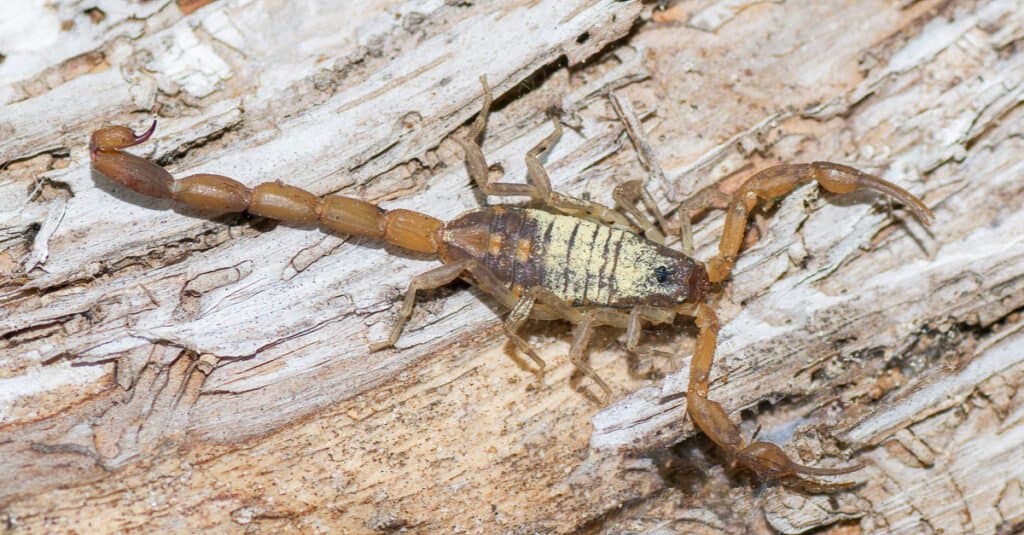
Hentz striped scorpions are also called striped bark scorpions.
©Chase D’animulls/Shutterstock.com
Hentz striped scorpions are the most common species in the United States and live primarily across the Gulf Coast, including Alabama, where they prefer the coastal plains. They are also called striped bark scorpions.
These scorpions usually grow to as long as 2.75 inches. Their colors vary from light tan to dark brown. They have two dark, longitudinal stripes. The ocular tubercle is covered with a dark triangle.
They live in deserts, temperate grasslands, and deciduous and coniferous forests. They are often seen in cities and villages, hiding in sheds, barns, or houses. Striped bark scorpions feed on cockroaches and other similar animals. Although they’re timid around people and other animals, they’re pretty sociable with other scorpions.
A Hentz striped scorpion sting is very painful and causes swelling. However, they are not dangerous to humans. On the other hand, it’s even helpful to have them around the house, as they feed on cockroaches!
Southern Unstriped Scorpion
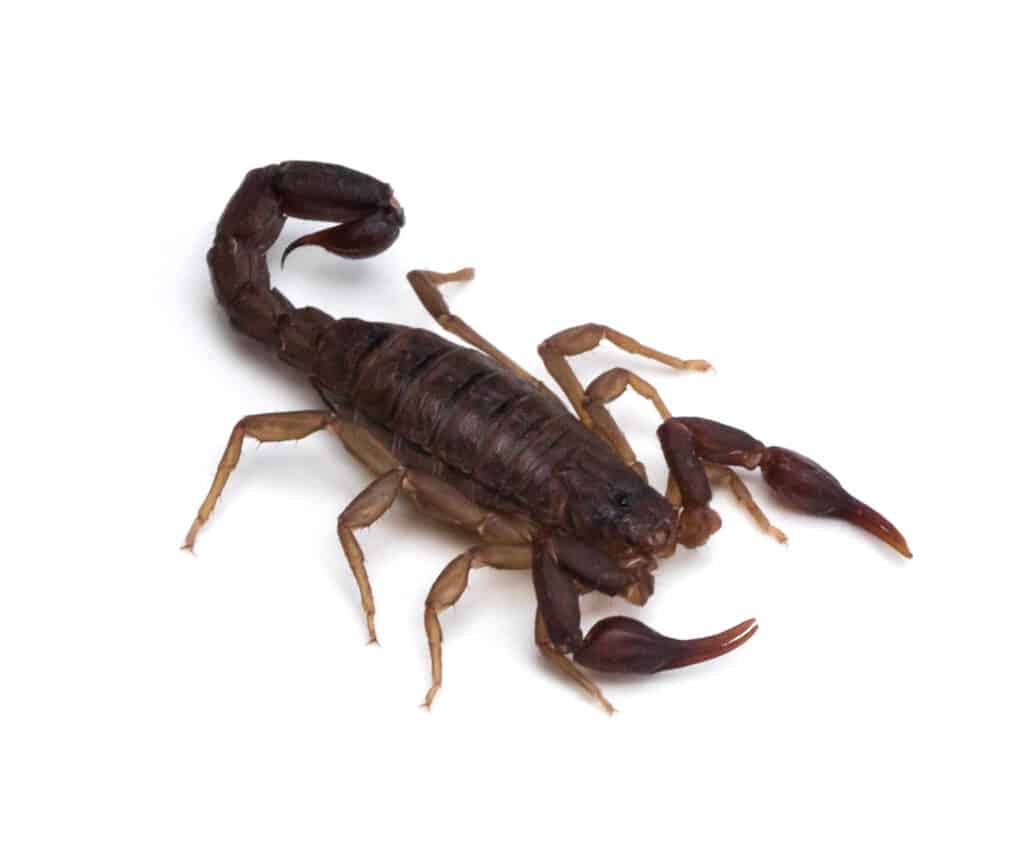
The average size of a southern unstriped scorpion is 1.5 inches.
©iStock.com/epantha
Southern unstriped scorpions are scientifically called Vaejovis carolinianus. They are common in Alabama, primarily in the central and northern regions. People often call them “southern devil scorpions.”
The average size of a southern unstriped scorpion is 1.5 inches. It is usually brown without any markings. Southern unstriped scorpions hide in debris piles, in brick foundations, and under logs. They feed on small insects.
Southern devil scorpions are a shy species. They’re always trying to avoid people or other animals. But, just like other scorpions, they’re more sociable with other species’ members, making it easier for them to mate.
Even though southern unstriped scorpions have venom, they are rarely dangerous to humans.
Are there pseudoscorpions in Alabama?
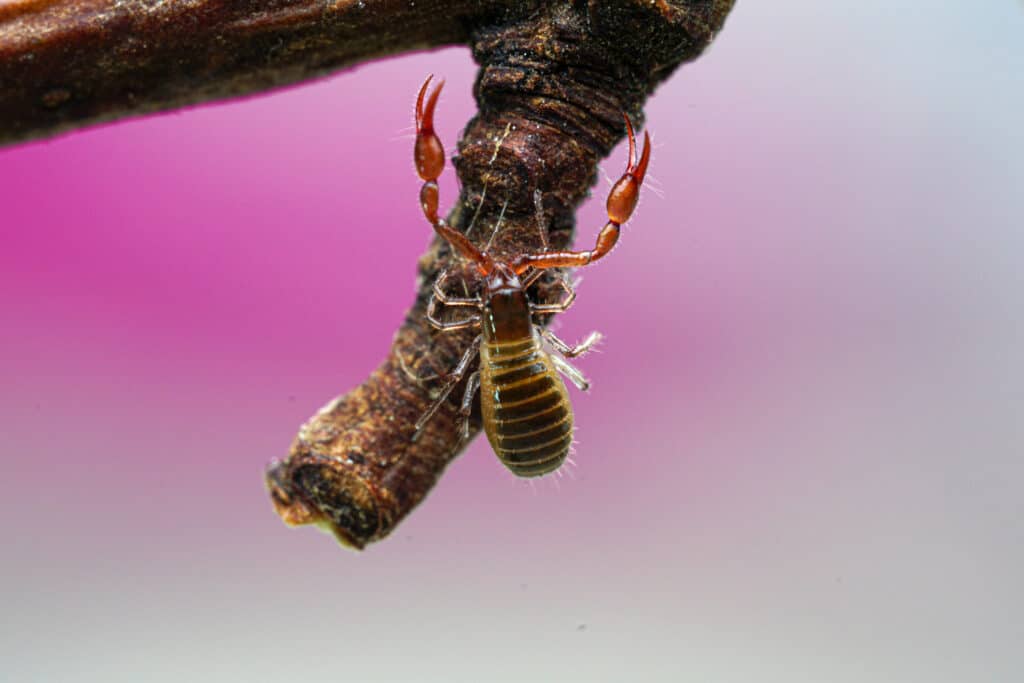
Pseudoscorpions are also known as book scorpions or false scorpions.
©iStock.com/David Birkenfeld
Pseudoscorpions are also known as book scorpions or false scorpions. So are they scorpions or not? What kind of animals are they?
These creatures are arachnids resembling scorpions, except that they lack tails. So they are scorpions without tails. Pseudoscorpions are common in Alabama. They live in the state’s cave systems, especially in Jackson, Marshall, and Madison counties.
The Encyclopedia of Alabama mentions 46 species of cave pseudoscorpions, and 40 of them are endemic to the region. These arachnids have eight legs, a two-sectioned body, and two appendages called pedipalps and chelicerae. They are smaller than scorpions, measuring 0.08–0.31 inches long.
Here are some pseudoscorpion species living in Alabama:
- Parachernes virginicus;
- Hesperochernes mirabilis;
- Alabamocreagris mortis;
- Alabamocreagris pecki.
Are Alabama scorpions poisonous?
Although poisonous, a striped bark scorpion’s venom is rarely deadly to humans. However, their bite is painful and causes swelling. Moreover, the neurotoxins in their venom can cause muscle spasms and paresthesia. There were rare cases of intense hypersensitive reactions that included chest tightness, abdominal cramping, flushing, nausea, and shortness of breath. This happens because the venom consists of proteins that are allergens to the human body. So, if a striped bark scorpion bites you, we strongly advise you to consult your doctor, especially if you have symptoms other than swelling and pain.
Hentz striped scorpions, southern unstriped scorpions, or southern devil scorpions are venomous but rarely dangerous to humans and usually cause pain and swelling only. However, some people may develop allergic reactions to the venom toxins and require medical attention.
What Keeps Scorpions Away?

Use of certain essential oils like peppermint can help deter scorpions from entering your home.
©rawf8/Shutterstock.com
The best way to avoid getting stung by a scorpion is to try and prevent them from entering your house in the first place. As scorpions can get into your house through holes and cracks, you can check for possible entryways with a flashlight. If the light gets through from the inside to the outside, you should fill that hole or crevice with an appropriate product.
Keeping your yard free of debris helps cut down on areas scorpions would gravitate to. Scorpions are also drawn to moisture, so you should keep areas around your home dry where leaks or puddles may occur. Caulking doors and windows is also a good strategy to keep them out.
Scorpions hate certain scents, especially cinnamon, so you can sprinkle it around the baseboards of your home to help deter them. Essential oils like lavender, peppermint, cedar, and cinnamon can also be used near potential entry points in your home to keep these pests away.
The photo featured at the top of this post is © Vova Shevchuk/Shutterstock.com
Thank you for reading! Have some feedback for us? Contact the AZ Animals editorial team.




